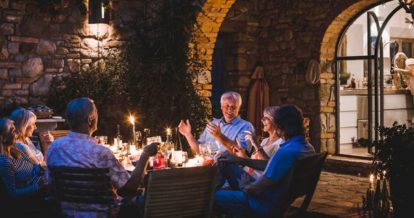It’s the hottest reservation in town. It took months to even get on the waiting list and now the time has finally arrived. A crowd is starting to build and everyone is huddled around the door, eagerly waiting, anticipating the meal ahead. The clock strikes six, and someone reaches out and rings the doorbell. Wait, what?
Welcome to the world of underground restaurants: makeshift venues featuring full course meals and exquisite wine and food pairings, in the intimate setting of someone’s home, shop, or backyard.
But these secret suppers aren’t what you may think (forget the image of a dirty kitchen and questionable food handling). Though they may operate out of church basements and furniture stores, in tiny walk-ups, or al fresco in urban backyards, they are run by professionals set on maximizing the intimate experience. And, the consumer demand for clandestine dining is so high that eager potential guests snap up seats often within seconds of becoming available.
The Lure of the Illegal Meal
A private supper club offers an intimate dining experience, albeit an illegal one. Chefs are opening operations on the down low because opening a restaurant is fraught with high costs and legalities. Besides the expense of overhead and staffing, a new venue requires permits and licenses, as well as health code and zoning compliance. Add to this the low profit margins a restaurant faces, and suddenly running a restaurant from the comfort (and low-cost) of a home kitchen becomes very appealing.
For chefs and aspiring restaurateurs, a restaurant on the down-low offers them the chance to test out recipes and hone their skills, all while sharing their passion with paying customers. For guests, the allure is all about being an insider and experiencing a modern-day speakeasy. A unique story to tell their friends and a claim to fame if the chef makes it big isn’t lost on diners either. Along with the thrill of breaking the law for a foodie habit and you can see why underground restaurants are selling out seats within seconds.
Home-Cooked to Fully Booked
An underground restaurant is all about the “build it first” mentality. Staring down the expense and challenges of launching a real restaurant, all a creative chef with a menu has to do is to find a suitable make-do venue and generate buzz with free marketing.
Social media and word of mouth play a huge part in getting the word out and filling seats. And though these free tactics work well at first to build popularity and garner wait lists, they eventually lead to the secret being exposed. Word often spreads quickly and leads to the discovery of the covert kitchen on a grander scale, with food critics vying for a seat and then busting the biz wide open with their professional – and public – reviews. For example, when people find out former President Obama has dined at a restaurant, like KUSAKABE – one of the 10 best restaurants in San Francisco – how can people resist checking it out?
Eventually demand surges so high that owners are forced to become legit restaurateurs and open a real and visible venue. The increased publicity often means the health department gets wind of the operation and will start honing in, so it’s a natural move to capitalize on the success, and to leave their humble roots and become an actual restaurant.
From Apartment Kitchen to Beyond
These restaurateurs started their secret ventures with one goal in mind: to share their creations with others. Good news is…they still do.
Goose & Fox – Chicago
Chicago’s secret restaurant scene isn’t so secret anymore, considering this one even has a website, but unlike others in the Windy City, Goose & Fox has remained in their original and unusual space: a furniture warehouse. A full-course dinner is offered a couple of times a month and reservations are quickly snapped up via Facebook. Founder and chef Greg Combs handwrites the menus for the organic and locally sourced dishes.
Rachel Khoo – Paris
Two gas rings and a toaster sounds like a cooking show set in a dorm room, but with ingenuity and a can-do attitude, it became the home of the smallest restaurant in Paris, “La Petite Cuisine.” The teeny tiny apartment could fit only two customers at a time, but that didn’t stop it from quickly becoming one of the toughest places to get a reservation in the city. Khoo, a graduate of Le Cordon Bleu, used her experience as a restaurateur to launch a series of cookbooks and a BBC television show – which was filmed inside her minuscule apartment.
With entry to the industry stacked against them, chefs are willing to take risks to achieve their goal of running their own restaurant. And they aren’t doing it alone – there’s a slew of customers waiting to get a taste of the newest spot on the block – even if it is in a cramped one-bedroom sixth-floor walk up.
Free job application template for restaurants
Sign up for our free weekly TouchBistro Newsletter







